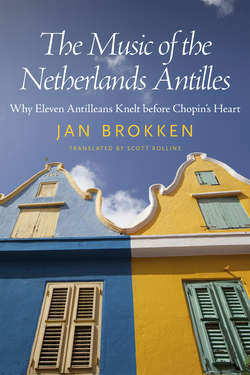Читать книгу The Music of the Netherlands Antilles - Jan Brokken - Страница 11
На сайте Литреса книга снята с продажи.
3 The Faintest Idea
ОглавлениеDuring the hottest part of the rainy season, in the last week of November 1993, I was sitting on a hard pew of the Fortkerk under a sky blue ceiling, not far from the chancel, one of four hundred in attendance. The audience—young, old, white, brown, black—were cooling themselves off with handkerchiefs and fans made of lace. The shutters were open; in the distance the bass whistle of a cruise ship resounded as it left the harbor, like a starting signal, or so it seemed, to the boisterous evening that lay ahead.
Cultural events are held on days of the week besides Sunday in that eighteenth-century Protestant church—in architectural terms a Dutch town church; in terms of color a white missionary’s church in the tropics; and in its location inside Fort Amsterdam, directly opposite the government building, a fortified church built during the reign of the Dutch West India Company.
The events are organized by a committee, the key figure of which is Millicent Smeets-Muskus. Her snow-white skin is testimony to her Swedish origins in the village of Muskuse, near the border with Lapland; her family nevertheless has been living on Curaçao for over three centuries. Just like many descendants of those early colonists, the Muskussen have become confirmed patriots who cherish the local traditions as they would exotic plants.
That evening in November Millicent—or Dudi as she is called—had arranged a concert for six pianists from Curaçao, Aruba, and Bonaire. They had agreed among themselves that each would be responsible for playing works from a certain era. In two hours the entire history of Dutch Antillean classical music from 1850 to 1990 whirled past.
I heard waltzes, contradances, and mazurkas.
After the concert Dudi received guests at home. Once the pianists had quenched their thirst, they slid back behind the piano, one or even two or three at a time, improvising to their heart’s content and turning the waltzes and mazurkas into a jam session. The atmosphere was lighthearted and exuberant; the older guests could no longer stay seated and began whirling through the room with youthful ease and timeless grace.
Among those making a night of it were August Willemsen, the Dutch translator of Fernando Pessoa, Drummond de Andrade, and Machado de Assis. He had come to Curaçao especially to attend a translation project. Papiamentu, the language of the Leeward Islands of the Dutch Antilles, resembles Portuguese and Spanish. Willemsen would be leading a number of workshops. I had met him on several occasions in Holland on the literary circuit there, or in the kitchen of a Brazilian girlfriend, who he helped prepare native dishes. Many years later our paths again would cross in Melbourne, Australia, where he had gone to begin a new life.
“What kind of colonizers are we?” Willemsen cried above the sounds of the piano. “How come we have never heard this music in Holland? The Portuguese know about Brazilian music, they are familiar with Villa-Lobos, but we haven’t got the faintest idea that there is such a thing as an Antillean mazurka. These islands have belonged to Holland for over 350 years, much longer than Brazil was a part of Portugal. And we know nothing, we cannot believe our ears. I don’t know about you but I am really starting to feel a strong sense of indignation. As if I have been kept in the dark on purpose.”
Even though he had partaken liberally of the local libation, he was making perfect sense. When it came to matters of culture, the Netherlands in its long colonial past had only possessed one colony: Indonesia. The other territories had just been conquered lands, populated by people with the status of mules and the cultural refinement of parrots.
Johnny Kleinmoedig was the youngest pianist that evening, thirty-one years old at the time, born in 1962. In the Fortkerk, sitting in the front row, were his black father and white mother, a touching sight: the black father tapping his foot in time to the music, the white mother, ever so softly, humming the melody to herself. Edgar Palm was the oldest pianist, a bald, jovial, chubby man with a pair of glasses he must have bought back in the 1950s that were perched crookedly on his nose. Born in 1905, now eighty-eight, he was still full of vigor, at least behind the piano. Padú del Caribe (b. 1920), Wim Statius Muller (b. 1930), Dominico Herrera (b. 1931), and Livio Hermans (b. 1935) formed the links between the oldest and youngest generation.
Regardless of their ages, the pianists all played with their souls. I saw it, I heard it: this was music that belonged to its performers like an effervescent tradewind; this was music they had grown up listening to from the cradle, like a language you pick up while playing with it and that later you no longer have to make a conscious effort to learn. They played music for their pleasure, at the concert, after the concert; they played half the night, till the crowd of listeners had thinned and the servants began cleaning up the glasses. Of all the guests, the pianists were the last to leave, together with August Willemsen and me, for we did not want to miss a single note of the festivities nor a drop of the local punch.
